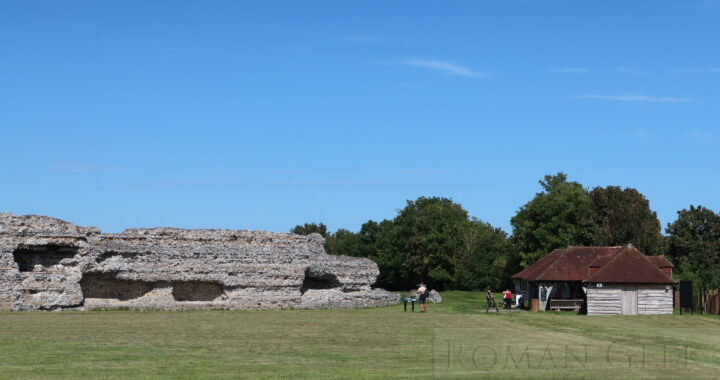- Richborough is a village near Sandwich in Kent and is the location of Legionary Fortress of Rutupiae, one of the Saxon Shore Forts.
- Founded in c. 43 CE, it was the official entry point into Roman Britannia from Gaul. The site is managed by English Heritage.
Roman Sites
- Richborough Roman Fort
- Roman Fortress Walls.
- Roman Amphitheatre.
The Saxon Shore Forts
- Richborough was part of the Saxon Shore Forts, a chain of Roman Forts in southeastern England that stretched from Portchester to the Wash, whose function was to defend the River estuaries and coastline from Pirate attacks by seaborne invaders.
- The Forts date to the third century CE and are mentioned in a 4th century CE document known as the Notitia Dignitatum.
Richborough was the Official Point of Entry to and from Gaul
- The Notitia Dignitatum states that Richborough (Rutupiae) was the official point of entry into Britannia from Boulogne (Gesoriacum), and that the distance was 450 stades or 56 Roman miles.
- Entry was through a Triumphal Arch inside the Fortress, and then up to London via Watling Street (the modern A2).
- To get to Richborough, a ferry was taken across the ‘Fretum Gallicum’, the Straits of Dover, from the Fortress of Boulogne in Gaul.
Watling Street
- Watling Street started at Richborough and continued to London and Wroxeter, where it divided and served the two Legionary Fortresses of Caerleon and Chester.
- Watling Street appears to have been the main road for the British Legions to march to the Continent, and vice versa.
Antonine Itinerary
- Iter II of the 4th century CE Antonine Itinerary describes the route between Hadrian's Wall, York, Chester and Wroxeter and then along Watling Street to Richborough.
Legionary marching route to Germany
- Watling Street connected from Richborough to Wroxeter where it divided, with one arm going to Chester, home of the Legio XX Valeria Victrix, and another arm going to Caerleon, home of the Legio II Augusta.
- A unit of the Legio II Augusta was still based at Rutupiae (Richborough) in late c. 400 CE, according to the Notitia Dignitatum, despite having closed their base at Caerleon one hundred years earlier.
- All Roman Roads in Italy and the Provinces had Way Stations known as the Statio. These were manned by the legionaries. This ensured that a road like Watling Street was clear to use for rapid Troop Movements during an emergency, either in Britannia or on the Continent.
Via Belgica
- The Via Belgica was the Roman Road from Boulogne to Cologne on the Rhine.
- In 71 CE, the Legio XIV Gemina, based in Wroxeter, are recorded as marching along the Via Belgica when they left Britannia to quell the Batavian Revolt in Germania Inferior.
- They would have marched from Wroxeter along Watling Street to Richborough, before sailing to Boulogne, and marching along the Via Belgica to Cologne.
Richborough Roman Fort and Amphitheatre

